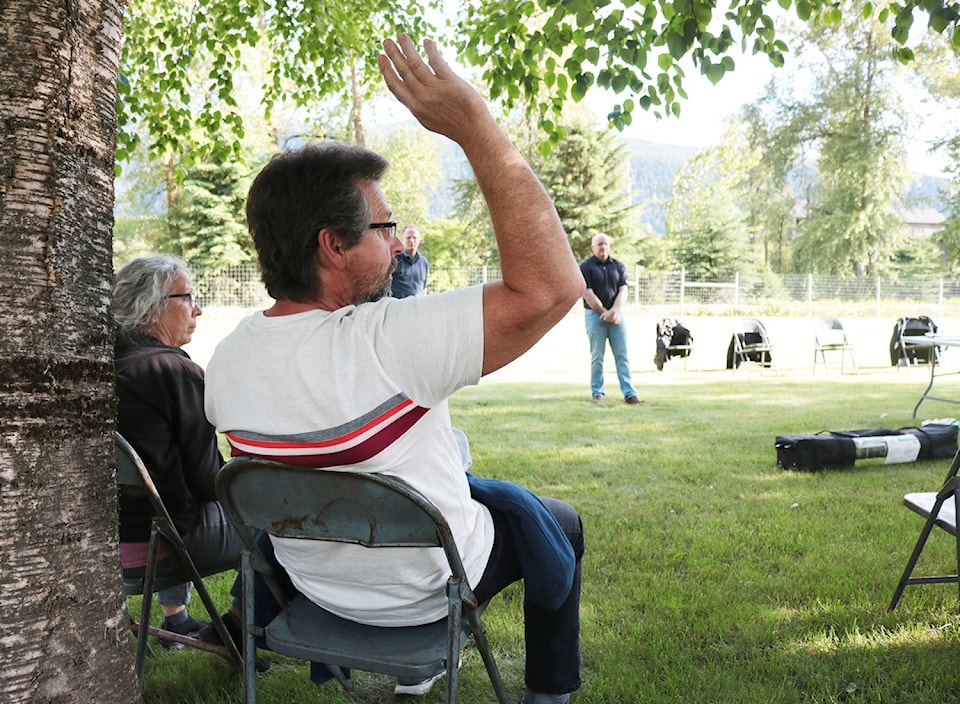Frustrated after having gone through another year of flooding, residents of Johnson Flats aired their concerns and questions to local government officials last month at a public meeting at a riverfront property, lined by a lengthly berm of sandbags.
The meeting was called just a few days after the community banded together to block a gap in the riverbank with sandbags during the river’s peak flow on June 1, after they learned no official temporary protection work would be done in the area. Considering wildly fluctuating river forecasts and the state of the soggy ground at the site on the southeast corner of the neighbourhood, Regional District of Kootenay Boundary CAO Mark Andison said, any more sizeable emergency repair would have been risky.
Nevertheless, residents used the June meeting to plead their case for permanent work to be undertaken.
Ray Morasse has lived in Johnson Flats for more than a decade. His property has flooded three out of the last four years, he said. “This is absolutely asinine. I can’t live like this. […] How am I supposed to live in this community – I’m feeling like the biggest mistake I’ve made in my life is investing in this town.”
“I need to know why we’re not having something done to protect us,” said CloAnne Morasse. “What I’m getting […] is that we’re not as important as any place else – we don’t count. That’s what we’re hearing, and that’s what I’d like an answer to.”
RDKB Area D director Roly Russell, Andison, and representatives from Grand Forks and the RDKB explained how a funded, emergency berm failed to materialize. The soft ground would have made its structural integrity precarious, and if the Kettle were to run higher than 2018 levels, as was predicted just days before its peak, the river would have overtopped the riverbank at other points throughout the neighbourhood, Andison said. The province’s deputy inspector of dikes denied the emergency build on May 30. The next day, volunteers began sandbagging.
As a temporary measure, Russell, said, any government-funded berm would have had to have been ripped out afterwards as well, because it would not adhere to permanent structure engineering specifications.
Many people at the meeting said they were not asking for anything beyond help returning the damaged section of riverbank to its pre-2018 condition.
“It was there. It broke. Put it back,” said one attendee.
Out of the more than $50 million in federal and provincial grants Grand Forks was promised last year for disaster mitigation and adaptation, areas outside of the city, such as the south end of Johnson Flats, are slated to receive between $3 and $4 million, mostly for bank reinforcements, Andison said.
Before moving to allocate money to repair riverbank stretches in Johnson Flats, the RDKB says it has to wait on a more in-depth study of the Kettle River. “I don’t have I don’t have the tools to make that decision right now,” Russell told residents.
“Look at the people that went out there [as the river rose on May 31 and June 1] doing all the sandbagging,” said Carol McQuarrie, who hosted the meeting on her property. “They were there until 1:30 in the morning with lights on, water freezing, to save us down here – that, to me, that is a huge risk assessment.”
Russell said that he would continue the conversation with residents to figure out a plan to repair the riverbank, but the bill would likely end up falling on the property owners who benefit from the work.
Related: ‘Not technically feasible’: Grand Forks volunteers stack sandbags to fill in damaged dike
@jensenedw
Jensen.edwards@grandforksgazette.ca
Like us on Facebook and follow us on Twitter.
